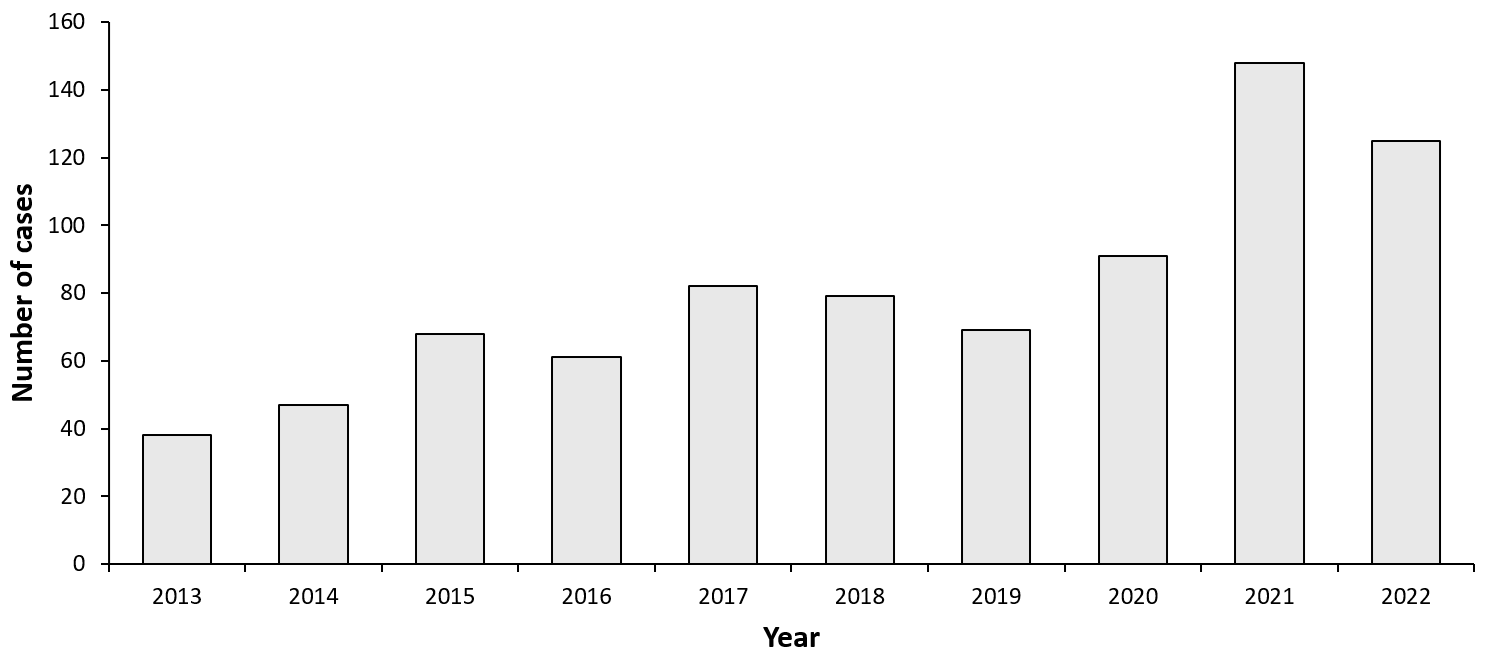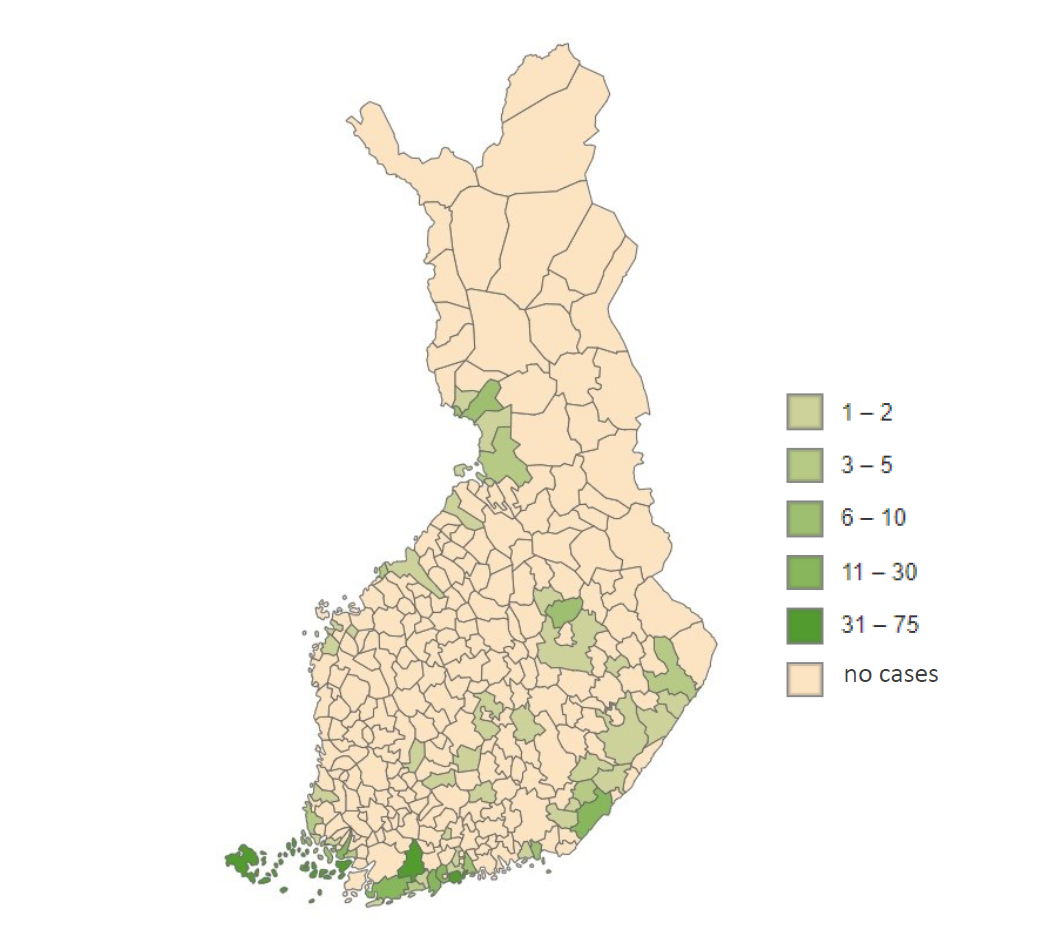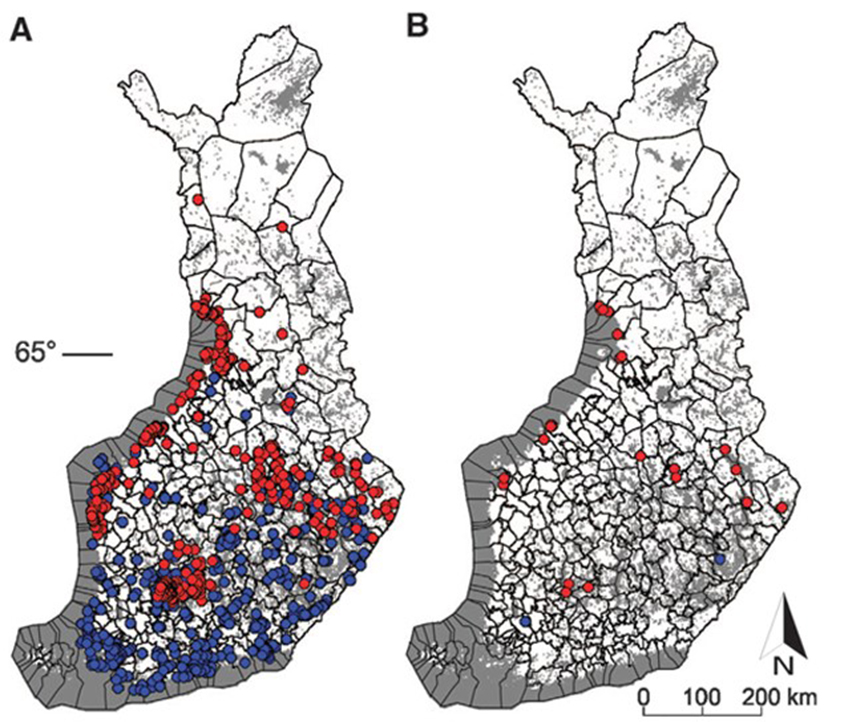Anu Jääskeläinen and Heidi Åhman
E-CDC risk status: endemic
(data as of beginning of 2023)
History and current situation
Finland is at the northernmost edge of the TBE endemic area in Europe. Here TBE is focally endemic. An aseptic encephalitis disease has been known in Kumlinge Island in Åland Islands since the 1940s.1 TBE is also known in Finland by name Kumlinge disease.
According to a legend, tick-borne encephalitis–like disease was known in the Åland Islands already in the 18th century.2 However, this is apparently a misunderstanding due to a doctoral thesis of archipelago fever in the Turku region published 1781, which describes malaria, not TBE.2
TBEV foci were determined in the 1960s by screening TBEV antibodies in cattle from all over the country.3 The endemic areas remained the same throughout decades until the 1990s, when Isosaari Island at the archipelago of Helsinki was found to be TBE endemic.5 Since then, sporadic human cases have appeared in new areas, like in Närpiö on the western coast and in eastern Finland in Varkaus, in the Kuopio region and in the Kotka archipelago.6 2008 human cases were traced to Simo, the world’s northernmost TBE endemic foci in Finnish Lapland,7 which is nowadays a high endemic focus where residents are vaccinated against TBE in national immunization program.
Tick distribution in the country was studied in 1950s8 and 2015 using crowdsourcing.9 Compared with the nationwide distribution map drawn in 1960s, the distribution of ticks has extended up to 200 km northwards.9
The northernmost tick samples were from latitudes of 67°, but it is unclear whether ticks there are from stable populations or are stragglers transported there with animals. However, populations have established in new locations, i.e. the Bothnian Bay coast and the eastern part of central Finland. In addition, TBEV RNA has been detected or TBEV isolated from ticks in areas formerly unknown to be TBE endemic and areas where only sporadic TBE cases have been reported.9
Both TBEV vector tick species, Ixodes ricinus and Ixodes persulcatus, are distributed in Finland.4,10 I. persulcatus is more abundant than I. ricinus in certain areas, such as in northern Finland where it is the dominant tick species. Both species have been shown to transmit TBEV-Eur and TBEV- Sib in Finland.6,7
The overall prevalence of TBEV in ticks in Finland is reported to be 1.6%.9 TBEV pre-valence was higher in I. persulcatus (3.0 %) than in I. ricinus (0.2 %) in 2015 based on ticks sampled by crowdsourcing9 but varies greatly within Finland.
Overview of TBE in Finland
| Table 1: Virus, vector, transmission of TBE in Finland | |
|---|---|
| Viral subtypes, distribution | European and Siberian subtypes4,9 |
| Reservoir animals | Microtus agrestis, Myodes glareolus10 |
| Infected tick species (%) | I. ricinus, I. persulcatus. In average 1.6%; I. ricinus 0.2%, I. persulcatus 3.0%9 In (suspected) endemic foci, TBEV RNA prevalence in field-collected ticks has been reported to be about 0.1%–3.0%4,10,11 |
| Table 2: TBE-reporting and vaccine prevention in Finland | |
|---|---|
| Mandatory TBE reporting | All patients with TBEV IgM antibodies are reported to National Infectious Diseases Register at National Institute for Health and Welfare; a group of experts interviews the patients and/or reviews the reports to confirm the place of acquisition and that the cases are true TBE cases by definition |
| Other TBE surveillance | Sentinel animals not systematically screened |
| Special clinicalfeatures | Biphasic disease reported in about 30%12 |
| Available vaccines | Encepur, Encepur Lapset (Bavarian Nordic), TicoVac and TicoVac Junior (Pfizer) |
| Vaccination recommendations and reimbursement13 | Eligible for the TBE vaccines as part of the national program are persons aged 3 years and over who are domiciled in Finland and who live permanently in the following regions:
Persons staying for long periods of time in holiday homes in these risk areas are also entitled to free vaccination. The vaccine is necessary only for persons who are active in nature for at least 4 weeks during the snow-free season. A previously unvaccinated person will receive three free doses of the vaccine. A person who has not completed the basic series will also receive remaining doses of primary series free of charge as part of the vaccination program. Booster vaccinations for those who have received a three-dose vaccination series are currently not included in the vaccination program. TBE vaccination recommendations for other risk areas are based on incidence and case-by-case consideration. The vaccine is paid for by the vaccinee. In some situations, the employer is responsible for protecting the worker, in which case the need for vaccination is assessed by the occupational health service. |
| Vaccine uptake by age group/risk group/general population | 21%14 |
| Name, address/website of TBE National Reference Center | National Institute for Health and Welfare, THL, Mannerheimintie 166, 00300 Helsinki https://www.thl.fi |
Figure 1: Burden of TBE in Finland over time (Reference: National Registry of Infectious Diseases14)

The incidence rates vary from 0 to >15/100 000.
| Year | Number of Cases | Incidence / 105 |
|---|---|---|
| 1995 | 5 | 0.10 |
| 1996 | 8 | 0.16 |
| 1997 | 19 | 0.38 |
| 1998 | 16 | 0.31 |
| 1999 | 12 | 0.23 |
| 2000 | 42 | 0.81 |
| 2001 | 33 | 0.64 |
| 2002 | 38 | 0.73 |
| 2003 | 16 | 0.31 |
| 2004 | 29 | 0.56 |
| 2005 | 16 | 0.31 |
| 2006 | 18 | 0.34 |
| 2007 | 20 | 0.38 |
| 2008 | 23 | 0.43 |
| 2009 | 25 | 0.47 |
| 2010 | 38 | 0.71 |
| 2011 | 43 | 0.80 |
| 2012 | 39 | 0.72 |
| 2013 | 38 | 0.71 |
| 2014 | 47 | 0.86 |
| 2015 | 68 | 1.24 |
| 2016 | 61 | 1.11 |
| 2017 | 82 | 1.49 |
| 2018 | 79 | 1.43 |
| 2019 | 69 | 1.25 |
| 2020 | 91 | 1.64 |
| 2021 | 148 | 2.67 |
| 2022 | 124 | 2.23 |
Figure 2: Number of TBE cases during 2015–202117

Figure 3
(A) Distribution of samples (n=2038) screened for pathogens. Blue dots indicate collection points
for I. ricinus samples (n=1044) and red dots indicate collection points for I. persulcatus.
(B) Distribution of the samples that were positive for TBEV (n=32). Adapted from Laaksonen M, et al. 2007.10

Contact:
heidi.ahman@pfizer.com
Citation:
Jääskeläinen A, Åhman H. TBE in Finland. Chapter 12b. In: Dobler G, Erber W, Bröker M, Schmitt HJ, eds. The TBE Book. 6th ed. Singapore: Global Health Press;2023. doi:10.33442/26613980_12b11-6
References
- Oker-Blom N. Kumlinge disease; a meningoencephalitis occurring in the Aaland Islands. Ann Med Exp Fenn.1956;34:309-18.
- Brummer-Korvenkontio M. Virusten ja prionien luonnonhistoria. Helsinki University Press 2007. In Finnish
- Tuomi J, Brummer-Korvenkontio M. Antibodies against viruses of the tick-borne encephalitis group in cattle sea in Finland. Ann Med Exp Biol Fenn. 1965;43(3):149-54
- Jääskeläinen AE, Tikkakoski T, Uzcátegui NY, Alekseev AN, Vaheri A, Vapalahti O. Siberian subtype tickborne encephalitis virus, Finland. Emerg Infect Dis. 2006;12(10):1568-71.
- Han X, Aho M, Vene S, et al. Prevaence of tick-borne encephalitis virus in Ixodes ricinus ticks in Finland. J Med Virol. 2001;64(1):21-8
- Jääskeläinen A, Tonteri E, Pieninkeroinen I, et al. Siberian subtype tick-borne encephalitis virus in Ixodes ricinus in a newly emerged focus, Finland. Ticks Tick-Borne Dis. 2016;7(1):216-23.
- Jääskeläinen AE, Tonteri E, Sironen T, Pakarinen L, Vaheri A, Vapalahti O. European subtype tick-borne encephalitis virus in Ixodes persulcatusticks. Emerg Infect Dis. 2011 Feb;17(2):323-5
- Öhman C. The geographical and topographical distribution of Ixodes ricinus in Finland. Acta Soc. Pro Fauna et Flora Fenn. 1961;76(4):1-25
- Laaksonen M, Sajanti E, Sormunen J, et al. Crowdsourcing- based nationwide tick collection reveals the distribution of I. ricinus and I. persulcatus and associated pathogens in Finland. Emerg Microbes Infect. 2017;6(5):e31;doi:10.1038/emi.2017.17
- Tonteri E, Jääskeläinen A, Tikkakoski T, et al. Tick-borne encephalitis virus in wild rodents in winter, Finland, 2008- 2009. Emerg Infect Dis. 2011;17(1):72-5. doi: 10.3201/ eid1701.100051
- Jääskeläinen AE, Sironen T, Murueva GB, et al. Tick-borne encephalitis virus in ticks in Finland, Russian Karelia and Buryatia. J Gen Virol. 2010;91(Pt 11):2706-12.
- Metsi J, Vuorla M, Kantele A, Kuusi M and Oksi J. Puutiaisaivokuume Suomessa 2010-2012. Duodecim. 2015;131:1367-75.
- National Institute for Health and Welfare 2022. https://thl.fi/fi/web/infektiotaudit-ja-rokotukset/rokotteet-a-o/tbe-rokote-eli-punkkirokote. Updated March 1, 2022 (Accessed February 6, 2023)
- TBE Compliance and Coverage 2019 – Finland. Ipsos, November 2019
- National Registry of Infectious Diseases, National Institute for Health and Welfare THL https://www.thl.fi/ttr/gen/rpt/tilastot.html (Accessed May 10, 2023)
- National Institute for Health and Welfare https://www.thl.fi/ttr/gen/atlas/html/atlas.html?show=tbe_riskienarviointi (Accessed February 6, 2023)